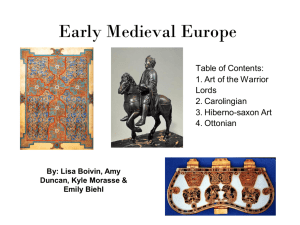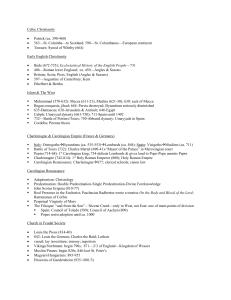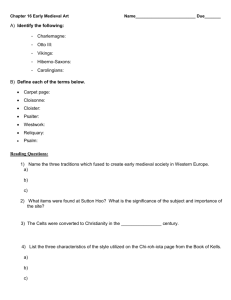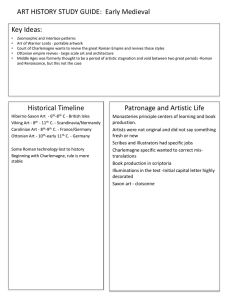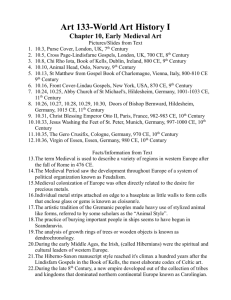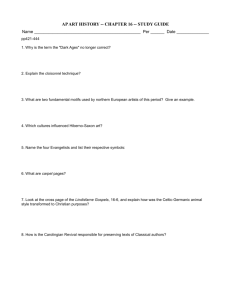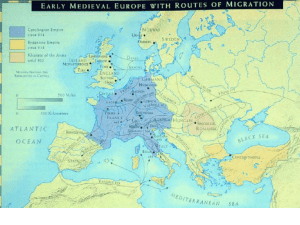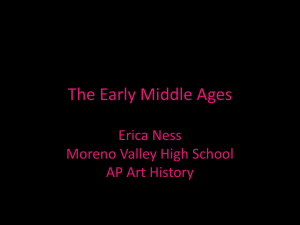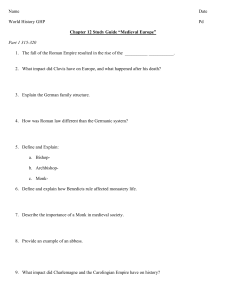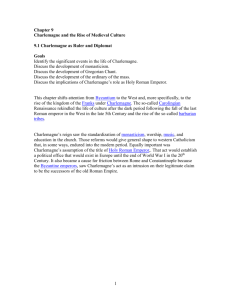File
advertisement
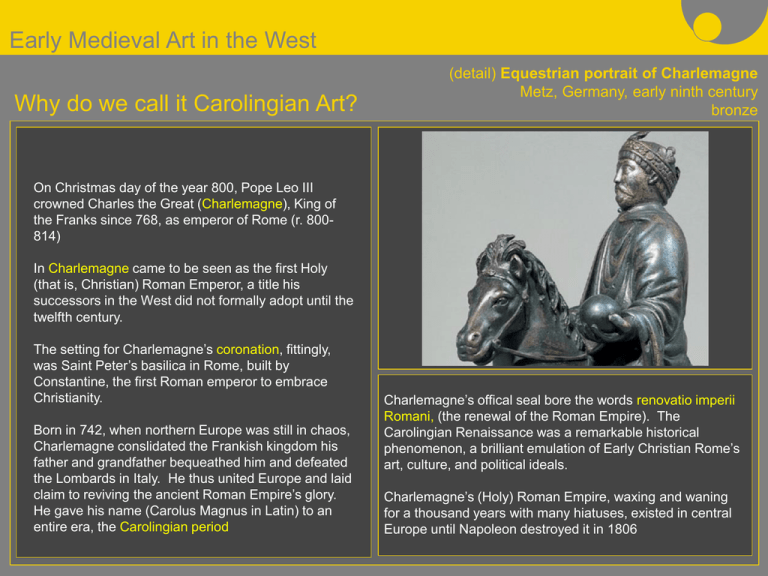
Early Medieval Art in the West Why do we call it Carolingian Art? (detail) Equestrian portrait of Charlemagne Metz, Germany, early ninth century bronze On Christmas day of the year 800, Pope Leo III crowned Charles the Great (Charlemagne), King of the Franks since 768, as emperor of Rome (r. 800814) In Charlemagne came to be seen as the first Holy (that is, Christian) Roman Emperor, a title his successors in the West did not formally adopt until the twelfth century. The setting for Charlemagne’s coronation, fittingly, was Saint Peter’s basilica in Rome, built by Constantine, the first Roman emperor to embrace Christianity. Born in 742, when northern Europe was still in chaos, Charlemagne conslidated the Frankish kingdom his father and grandfather bequeathed him and defeated the Lombards in Italy. He thus united Europe and laid claim to reviving the ancient Roman Empire’s glory. He gave his name (Carolus Magnus in Latin) to an entire era, the Carolingian period Charlemagne’s offical seal bore the words renovatio imperii Romani, (the renewal of the Roman Empire). The Carolingian Renaissance was a remarkable historical phenomenon, a brilliant emulation of Early Christian Rome’s art, culture, and political ideals. Charlemagne’s (Holy) Roman Empire, waxing and waning for a thousand years with many hiatuses, existed in central Europe until Napoleon destroyed it in 1806 Early Medieval Art Carolingian Art Figure 16-13 The Ebbo Gospels illuminator replaced the classical calm and solidity of the Coronation Gospels with an energy that amounts to frenzy, and the frail saint almost leaps under its impulse. His hair stands on end, his eyes open wide, the folds of the drapery writhe and vibrate, the landsccape behind him rears up alive. The painter even set the page's leaf border in motion. Matthew appears to take down in frantic haste what his inspiration dictates. The tiny angel in the upper-right corner is Matthew's inspiration. The angel is dictating to Matthew what he is to write down. Saint Matthew, from the Gospel Book of Archbishop Ebbo of Reims,Hautvillers (near Reims) , France, ca 816-835 Early Medieval Art Crucifixion, front cover of the Lindau Gospels, ca. 870 Carolingian Art The golden cover of the Lindau Gospels, fashioned in a workshop of Charles the Bald's court, is surrounded by pearls and jewels that are raised on golden claw feet so that they can catch and reflect the light even more brilliantly and protect the delicate metal relief from denting. The figures are rendered in repoussé, or hammered or pressed relief. The youthful Christ brings to mind the beardless unsuffering Christ of the fifth-century ivory casket from Italy. By contrast, the four angels and the personifications of the Moon and the Sun above and the crouching figures of the Virgin Mary and Saint John (and two other figures of uncertain identity) in the quadrants below display the vivacity and nervous energy of the Utrecht Psalter figures. This single eclectic work displays the classical and native stylistic poles of Carolingian art side by side. Figure 16-16 Early Medieval Art Crucifixion, commissioned by Archbishop Gero ca. 970 Ottonian Art This Crucifix, carved in oak and then painted and gilded, epitomizes the revival of interest in monumental sculpture during this period. The six-foot-tall image of Christ nailed ot the cross is both statue and reliquary [a shrine for sacred relics]. A compartment in the back of the head held the Host. This dramatically different conception of the crucified Savior digresses from the Early Christian image of the youthful Christ triumphant over death in that he is represented as an all-too-human martyr in intense agony. Though the work may seem more similar to the Byzantine representations of a suffering Christ, its emotional power is unparalleled. Blood streaks down his forehead from the (missing) crown of thorns. Christ's body sags under its own weight. The muscles are stretched to the limit - those of his right shoulder and chest seem almost to rip apart. Figure 16-27 Early Medieval Art Annunciation to the Shepherds Reichenau, Germany ca. 970 Ottonian Art Although the angel is a far cry from the dynamic marble Nike of Samothrace of Hellenistic times, the framed panel still incorporates much that was at the heart of the classical tradition, including the rocky landscape setting with grazing animals. The golden background betrays, however, knowledge of Byzantine book illumination and mosaic decoration. The angel looms immense above the startled and terrified shepherds, filling the golden sky, and bends on them a fierce and menacing glance as he extends his hand in the gesture of authority and instruction. Emphasized more than the message itself are the power and majesty of God's authority. The artist portrayed it here with the same emotional impact as the electric force of God's violent pointing in the Hildesheim doors. Figure 16-28 Early Medieval Art Ottonian Art Of the three Ottos, Otto III dreamed the most of a revived Christian Roman Empire; indeed, it was his life's obsession. His mother was a Byzantine princess, and he was keenly aware of his descent from both Eastern and Western imperial lines. He moved his court, with its Byzantine ceremonial, to Rome and there set up theatrically the symbols and trappings of Roman imperialism. Otto's romantic dream of imperial unity for Europe never materialized. He died prematurely, at age 21, and, at his own request, was buried beside Charlemagne at Aachen The illuminator represented the emperor enthroned, holding the sceptor and cross-inscribed orb that represent his universal authority, conforming to a Christian imperial iconographic tradition that went back to Constantine. He is flanked by the clergy and the barons (the Christian Church and the state), both aligned in his support. On the facing page (not illustrated), classicizing female personifications of Slavinia, Germany, Gaul, and Rome the provinces of the Ottonian Empire - bring tribute to the Figure 16-29 young emperor. Otto III enthroned from the Gospel Book of Otto III, Trier,Germany ca 970
